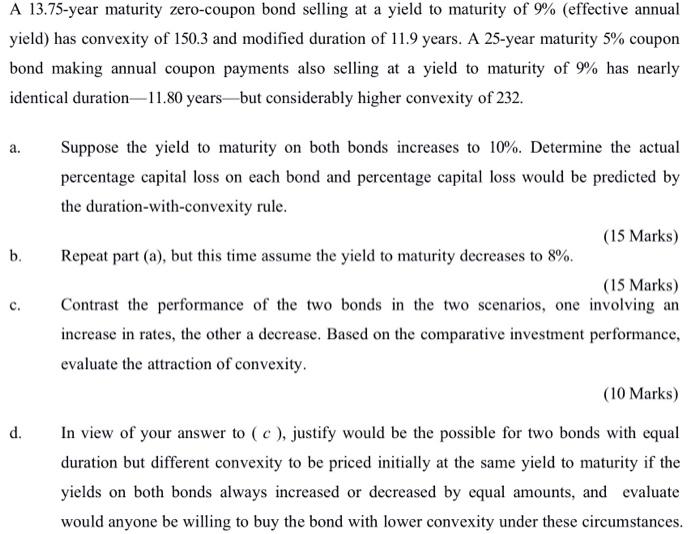Please write down the steps of C and D in detail.

A 13.75-year maturity zero-coupon bond selling at a yield to maturity of 9% (effective annual yield) has convexity of 150.3 and modified duration of 11.9 years. A 25-year maturity 5\% coupon bond making annual coupon payments also selling at a yield to maturity of 9% has nearly identical duration-11.80 years - but considerably higher convexity of 232. a. Suppose the yield to maturity on both bonds increases to 10%. Determine the actual percentage capital loss on each bond and percentage capital loss would be predicted by the duration-with-convexity rule. b. Repeat part (a), but this time assume the yield to maturity decreases to 8%. (15 Marks) (15 Marks) c. Contrast the performance of the two bonds in the two scenarios, one involving an increase in rates, the other a decrease. Based on the comparative investment performance, evaluate the attraction of convexity. (10 Marks) d. In view of your answer to (c), justify would be the possible for two bonds with equal duration but different convexity to be priced initially at the same yield to maturity if the yields on both bonds always increased or decreased by equal amounts, and evaluate would anyone be willing to buy the bond with lower convexity under these circumstances. A 13.75-year maturity zero-coupon bond selling at a yield to maturity of 9% (effective annual yield) has convexity of 150.3 and modified duration of 11.9 years. A 25-year maturity 5\% coupon bond making annual coupon payments also selling at a yield to maturity of 9% has nearly identical duration-11.80 years - but considerably higher convexity of 232. a. Suppose the yield to maturity on both bonds increases to 10%. Determine the actual percentage capital loss on each bond and percentage capital loss would be predicted by the duration-with-convexity rule. b. Repeat part (a), but this time assume the yield to maturity decreases to 8%. (15 Marks) (15 Marks) c. Contrast the performance of the two bonds in the two scenarios, one involving an increase in rates, the other a decrease. Based on the comparative investment performance, evaluate the attraction of convexity. (10 Marks) d. In view of your answer to (c), justify would be the possible for two bonds with equal duration but different convexity to be priced initially at the same yield to maturity if the yields on both bonds always increased or decreased by equal amounts, and evaluate would anyone be willing to buy the bond with lower convexity under these circumstances








